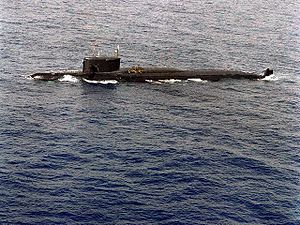Yankee-class submarine
 
Damaged K-219
|
|
| Class overview | |
|---|---|
| Name: | Yankee class |
| Builders: | Severodvinsk and Komsomolsk |
| Operators: |
|
| Preceded by: | Hotel class submarine |
| Succeeded by: | Delta class submarine |
| Completed: | 34 |
| Active: | 0 |
| Lost: | 1 |
| Retired: | 33 |
| General characteristics | |
| Displacement: |
|
| Length: | 132 m (433 ft) |
| Beam: | 11.6 m (38 ft) |
| Draught: | 8 m (26 ft) |
| Propulsion: | two pressurized water cooled reactors powering four steam turbines driving two shafts. |
| Speed: |
|
| Range: | unlimited |
| Complement: | 120 |
| Armament: |
|
The Yankee-class was a class of Soviet nuclear ballistic missile submarines that was constructed from 1967 onward. 34 units were produced under Project 667A Navaga (after the fish) and Project 667AU Nalim ("burbot"). 24 were built at Severodvinsk for the Northern Fleet while the remaining 10 built in Komsomolsk-na-Amurye for the Pacific Fleet. Two Northern Fleet units were transferred to the Pacific. The lead unit K-137 Leninets, receiving its honorific name 11 April 1970, two and one half years after being commissioned.
The Yankee-class nuclear submarines were the first class of Soviet ballistic missile submarines (SSBN) to have thermonuclear firepower comparable with that of their American and British Polaris submarine counterparts. The Yankee-class were quieter in the ocean than were their Hotel-class predecessors, and had better streamlining that improved their underwater performance. The Yankee-class were actually quite similar to the Polaris submarines of the U.S. Navy and the Royal Navy. These boats were all armed with 16 submarine-launched ballistic missiles (SLBM) with multiple nuclear warheads as nuclear deterrents during the Cold War, and their ballistic missiles had ranges from 1,500 nautical miles (2,400 kilometers) to 2,500 miles (4,000 kilometers).
...
Wikipedia
